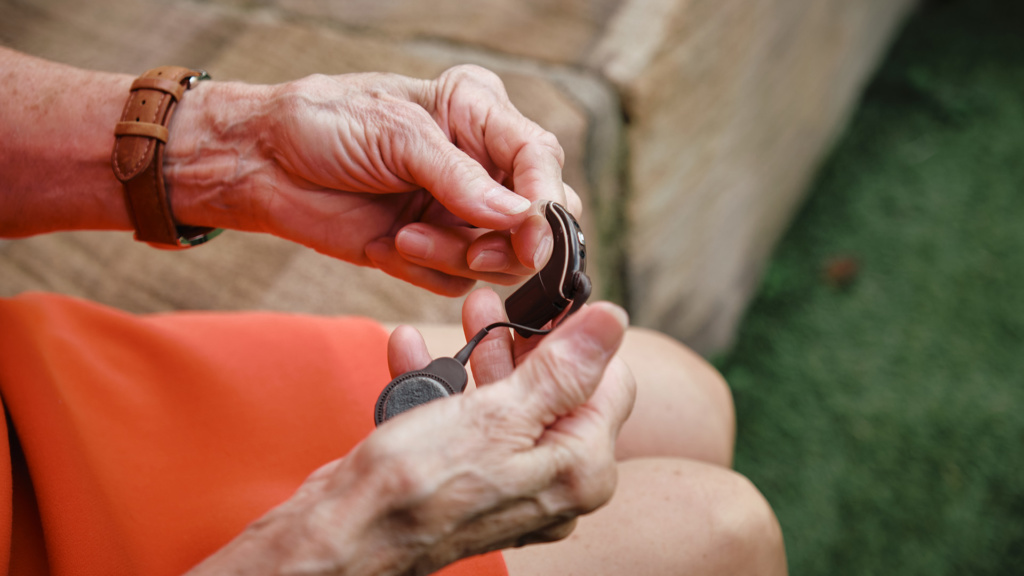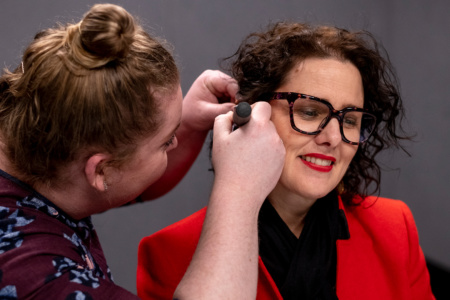Cochlear implants are surgically implanted bypassing the standard hearing process. Cochlear implants are designed to mimic natural hearing and undertake some of the functions of the inner ear by converting sounds into electric signals to stimulate the auditory nerve.
Cochlear implants have two key parts:
the internal component which is the implant itself placed under the skin and attached to an array of electrodes placed in the inner ear
the external sound processor that is worn behind the ear and/or off the ear
The sound processor picks up sounds and converts them into a signal that is transmitted to the implant bypassing the damaged part of the ear that is not functioning.
How does a cochlear implant work step by step?
Designed to mimic the functions of the human ear, cochlear implants work with the following steps:
The microphone of the cochlear implants
The microphones which sit on the sound processor worn on the head pick up external sounds. The processor then converts these sounds into digital information.
The transmitter coil
This information is then transferred through the transmitter coil to the cochlear implant which sits under the skin.
The implanted receiver
The implant under the skin then sends electrical signals down to the electrode sitting in the cochlea (inner ear).
Electrodes and the brain
The hearing nerve fibres in the cochlea (inner ear) pick up the signals and then send them to the brain, which is where the sensation of sound comes from. Unlike hearing aids which amplify sounds to make them louder, cochlear implants send sound right to the hearing nerve which then goes into the brain.
(C) Cochlear Limited 2021. This material is reproduced with the permission of Cochlear Limited.
What procedure is needed to install a cochlear implant?
There are multiple steps to go through when preparing for a cochlear implant, including:
Cochlear implant evaluation
The first step is determining if you are a candidate for cochlear implants. This includes an extensive medical, audiological and speech and language evaluation to determine if you’re suitable for a cochlear implant. These tests include:
Hearing tests
Speech discrimination with and without hearing aids
MRI
Psychological testing


Cochlear implant surgery
Cochlear implant surgery is completed by a qualified Ear, Nose and Throat (ENT) surgeon. It takes up to two hours to do the cochlear implant surgery. The ENT will insert the implant underneath your skin behind the ear, on top of your skull, and the electrodes are inserted into the inner ear. After this, the ENT tests the implant during surgery to make sure it is working.
Cochlear implant switch on
After you have healed from the cochlear implant surgery, the implant can be switched on by a qualified audiologist which is essentially activating the hearing device. This usually takes place approximately one to two weeks after the cochlear implant surgery.
This is when the audiologist also programs the cochlear implant to fine-tune the sound. Generally, the volume is increased over a series of appointments to give the brain time to adapt to the new sound.
Ongoing programming and support
After the switch on, ongoing support includes an audiologist and speech therapist. The speech therapist can help train your brain to interpret sounds heard via the cochlear implant and recognise what they mean. They'll guide you to get the most from your cochlear implant which might be through regular appointments as well as some homework at home via apps streamed to your processor.
How does the world sound through a cochlear implant?
The sound in which someone perceives through their cochlear implants is different to that of normal hearing. People who wear cochlear implants and who have previously had normal hearing have described the sound to be robotic or even tinny initially. However, as the brain adjusts to these new sounds, the sound becomes more natural.
Ella's cochlear implant switch on
Check out the video to see Ella’s cochlear implants being switched on for the first time. This is an emotional and exciting milestone when she hears sound for the first time, and only the beginning of her journey learning to hear and speak.
The history of the cochlear implant
Australian surgeon, Professor Graeme Clark successfully performed the world’s first cochlear implant surgery in 1978. This marked a new era of opportunity for people with severe to profound hearing loss. Like most technology, the cochlear implant has rapidly transformed since its conception early iterations. Gone are the body worn processors that users were once required to wear, now replaced with small slim behind the ear and off the ear processors with Bluetooth streaming.









